The rapid development of information technology makes intelligent decision support system play an increasingly important role in economic standardized management. The Intelligent Decision Support System (IDSS) constructed in this paper includes interaction layer, analysis layer and data layer. The system standardizes the management of enterprise economy through strategic forecasting and decision analysis, economic planning and control, and economic analysis. The study combines the fuzzy hierarchical analysis method (FAHP) and the fuzzy comprehensive evaluation method (FCE) to evaluate the standardized level of economic management of enterprise A. The evaluation score of the standardized level of enterprise A’s economic management is
Intelligent Decision Support System (IDSS), an information system based on artificial intelligence technology, is designed to assist decision makers in analyzing problems and evaluating decision options in the complex decision-making process, so as to provide high-quality decision-making strategies and programs [14, 8, 16]. It combines a variety of technical means such as data analysis, model building, decision rule setting, etc. It can process and analyze a large amount of data and information to provide decision makers with comprehensive and accurate decision-making support, which has the characteristics of data processing ability, information visualization, decision-making suggestions, intelligent learning ability, etc. It has an important role in the standardization of economic management [20, 21, 6, 11].
Since China’s reform and opening up, the economy has been developing rapidly, and Chinese enterprises have been affected by social and economic development [19]. Under the new environment, if enterprises want to keep pace with economic development and improve their own economic development level, they need to focus on the standardization of economic management on the basis of strengthening economic management, minimizing economic management errors and guaranteeing the quality of economic management [4, 17, 12, 13]. In fact, economic management is an important content of enterprise operation and management, which needs professional economic management personnel to be responsible for, and at the same time, it also needs standardized management mechanism to guide and restrain [5, 10, 18]. In addition, the development of market economy in the new environment has put forward new requirements for the economic management of enterprises, and enterprises need to focus on the innovation of their own economic management [3, 9, 2].
The intelligent decision support system constructed in this article can mainly perform strategic forecasting and decision analysis, economic planning and control, and economic analysis for economic management. In order to explore the implementation effect of intelligent decision support system in economic management standardization, the article is based on the fuzzy hierarchical analysis method to calculate the weights of the factors affecting the level of economic standardized management. Then the fuzzy comprehensive evaluation method is used to quantitatively calculate the economic standardized management level. Combined with the level evaluation standard, when
Intelligent Decision Support System (IDSS) is a combination of artificial intelligence and decision support system. Decision support systems are generally based on databases, on which there are a series of models and methods, while expert systems are generally based on knowledge bases, with which there are inference machines and dynamic databases closely linked [1]. The focus of IDSS research is to organically combine these two, to add knowledge reasoning into model operations, and to maximize the unstructured problem solving ability of decision support systems. The four library systems of intelligent decision support system refer to database system, model library system, method library system and knowledge library system, which are the core components of IDSS. Data is the basis of decision support, model is an organization of methods oriented to specific decisions, methods generally refer to algorithms based on operations research and simulation techniques, etc., which form the basis of the model, and knowledge is a collection of reasonably organized declarative and process-oriented knowledge about a specific domain.
The top management is the core leader of economic management. First of all, the top managers should be familiar with and pay attention to the economic management system and relevant economic laws and regulations, and at the same time strengthen the economic management consciousness of all middle and top managers and ordinary employees. When formulating economic management guidelines and models, they should maintain a high degree of consistency with the purpose. For the formulated economic management mode, managers must ensure its implementation in practice, and it is also very necessary to evaluate the implementation and effect of the economic management mode, and constantly improve and perfect the economic management system through the effective communication with all levels of managers and ordinary employees. If necessary, the manager should also assign a person to collaborate with himself to formulate and implement the economic management model as well as the evaluation and improvement work in the later stage.
Reasonable economic management documents are the fundamental guarantee for normal and efficient operation of economic management. The economic management documents should include the plan of economic management activities, policies and objectives of economic management, record manuals of economic management activities, and implementation manuals of economic management in written form.
For the constructed economic management system, the top management should evaluate it regularly, so as to ensure the continuity of the effectiveness, adequacy and suitability of the economic management system. The evaluation of the economic management system includes: the need for change and improvement of the economic management system, economic objectives and policies, results of internal audits, customer feedback, compliance with results and performance, implementation status of corrective and preventive measures, previous economic management evaluation measures, and recommendations that may have an impact on the improvement and change of the economic management system.
The establishment of a standardized economic management model not only requires the rational allocation of materials and funds, but also requires managers to select personnel with appropriate education, work experience, technical skills and professional training to engage in various activities related to economic management. Through training and other means, to enhance and guarantee the ability of personnel engaged in economic management results to ensure the effectiveness of evaluation measures. Strengthening staff awareness so that they are fully aware of the importance and relevance of their work and how it contributes to the achievement of economic goals. In addition, appropriate records of training, education, experience, and skills are maintained.
In order to achieve economic goals, the economic management model is required to plan for the following: determination of economic needs and goals, determination of needs for resources, documents, and processes, monitoring, inspection, and review activities required to achieve economic goals, and determination of communication and requirements of related parties. It is also necessary to carry out internal audits on a regular basis and assign appropriate auditors to carry out internal audits independently and impartially, so as to ensure the correct and effective implementation of the economic management model.
When a violation of the economic management model is found in the course of results measurement and monitoring, economic management, or internal auditing, it should be handled in the following manner: first, the cause of the incident should be identified, and then measures should be taken to resolve the identified problem. Secondly, effective measures should be taken to prevent the spread of the impact of the incident. The nature of the incident and the relevant measures taken in the event of non-compliance with the EMS should be recorded and kept.
Appropriate data should be collected and analyzed so that the effectiveness and adaptability of the economic management system can be guaranteed and the possibility of continuous improvement of the economic management model can be evaluated. Data sources are mainly measurements, monitoring results, and other relevant data. Before a situation occurs, it is necessary to formulate a response to the situation in order to eliminate potential violations of the economic management system.
Combined with the previous analysis, the architecture of the economic management intelligent decision support system constructed in this paper is shown in Figure 1. The hierarchical architecture of the system covers the interaction layer, analysis layer and data layer, and the functions of different hierarchical architectures are different. For example, the interaction layer is oriented to decision makers, in order to meet their economic management decision-making needs, it is key to realize human-computer interaction, and the speech recognition and natural language processing technology under AI technology provides a bridge for decision makers to communicate, and the system intelligently outputs the economic analysis report, prediction report, and decision-making report according to decision maker’s economic management goals. The analysis layer is the key to carry out economic analysis, forecasting, and decision-making, involving AI analysis systems, method libraries, knowledge bases, model libraries, etc., to carry out economic analysis and forecasting based on historical data and key indicators. The data layer is an important foundation for providing powerful data, including structured and unstructured data, fully relying on the natural language processing technology and automatic data transmission program of AI technology, carrying out a series of processing and conversion work on massive external information (macroeconomics, exchange rate, taxation, etc.) and useful information for internal decision-making (credit, auditing, business finance, etc.), and forming useful data with high degree of comprehensiveness.

After evaluating the past economic data, resources and environment, we utilize the intelligent decision support system to realize comprehensive strategic analysis, forecasting, decision-making and preference for sales, investment and financing, costs, survival, capital chain forecasting and receivables.
Economic planning and control is a strategic decision-making program to achieve the development of detailed strategic plans, mainly including economic budgets, business plans, target allocation, etc., to be able to show the economic decision-making action plan. Economic planning and control mainly includes economic budgeting, control and fund control, cost control, etc.
Economic analysis refers to the business data to judge the economic situation, abnormal grasp of the economic operation process, the main basis for decision-making for the relevant interests of the main body. Economic data, reports and other information as a basis, the use of external economic experts knowledge base system using advanced artificial intelligence technology, and a number of intelligent economic analysis indicators, models, combined with multiple indicators, multi-level dynamic analysis and judgment, so as to achieve intelligent analysis. Comprehensive analysis and evaluation of the board, operating results, and economic situation enables decision makers to understand the past, evaluate the present, and predict the future, so as to improve business decisions. The economic analysis system can be divided into revenue, profit, cost, gross profit, liabilities, period expenses, profitability, solvency, development ability, cash flow, business risk and other analytical contents according to the content of analysis.
Fuzzy hierarchical analysis method (FAHP) is mainly used for quantitative analysis of complex systems, according to the characteristics of the analysis object will be organized into a number of key elements of the analysis objectives, and then these elements are analyzed layer by layer to form a multi-layer analysis model, using the logical relationship between the factors to obtain the process of the importance of each factor [15]. The traditional hierarchical analysis method in the process of solving will have difficulty in meeting the consistency of the problem, so this paper improves the method, using fuzzy mathematics to standardize the construction of the judgment matrix, in order to ensure the reliability of the solution results, the main process of the method is as follows.
Indicator system construction is to organize the problems analyzed, clarify the general objective of the analysis, and summarize the independent sub-factors related to the general objective, and then analyze them layer by layer, finally forming a multi-level structural model, and dividing this hierarchy into the objective layer, the criterion layer, and the indicator layer in accordance with the logical relationship.
The guideline layer under the target layer in the indicator system,
and the corresponding indicator layer factors under each factor of the
guideline layer are compared two by two, and the contrast matrix formed
is called the judgment matrix, such as the sub-factor set of factor
Factor
In order to ensure that the results of the constructed judgment matrix satisfy the requirement of consistency (the essence is the consistency of the personnel’s cognition of things), it is necessary to ensure that the absolute difference of the corresponding factors between any rows of the matrix is a constant, and when it is a non-constant number, it will be adjusted in accordance with the principle of majority rule.
By solving the constructed fuzzy judgment matrix to get the weight
value corresponding to each factor affecting the standardized level of
economic management, i.e., the weight value set
In order to determine the relative importance of the indicator layer
factors relative to the target layer factors, it is also necessary to
carry out a total ranking of factors affecting the level of economic
management standardization. This solution process is calculated by the
combination of the weight of the indicator layer relative to the
criterion layer and the weight of the criterion layer relative to the
target layer, and the calculation process is:
Fuzzy Comprehensive Evaluation (FCE) is an analytical method based on
fuzzy mathematics for the evaluation of the overall state of the system,
through the industry experts on the analysis of the underlying factors
of the index system established by the system to determine the state
[7], and then combined with
the weight of these factors worth to the level of standardization of the
economic management of the overall state of the score, so as to
determine the effect of the implementation of the intelligent decision
support system in the economic management. The model of this method is:
| 70 |
50 |
30 |
30 |
||
|---|---|---|---|---|---|
| Normalized hierarchy | Good | Better | Medium | Poor | Bad |
This chapter uses the FAHP-FCE model to assess the level of economic management standardization of Enterprise A based on an intelligent decision support system.
According to Subsection 2.2, the standardized management of economy includes the construction of economic management system, the introduction of relevant documents for economic management, the evaluation of economic management system, the management of economic resources, the planning to achieve the economic goals, the measures to deal with the events, and the analysis of data. Accordingly, the evaluation index system of economic standardized management level constructed in this paper is constructed from the above seven dimensions. The constructed evaluation index system is shown in Table 2, with a total of 27 evaluation indexes at the factor level.
| Target layer | Criterion layer | Factor layer |
|---|---|---|
| The standardization of economic management of A enterprise (C) |
Economic management system (a |
Familiar with economic management (a |
| Familiar with the law of economic management (a |
||
| Management awareness of managers (a |
||
| Employee economic management consciousness (a |
||
| Economic management model (a |
||
| Relevant documents on economic management (a |
Economic management activity plan (a |
|
| Policy and objectives of economic management (a |
||
| Record manual for economic management activities (a |
||
| Executive manual of economic management (a |
||
| Evaluation of economic management system (a |
Economic management system change and improvement requirements (a |
|
| Economic goals and policies (a |
||
| Internal audit results (a |
||
| Customer feedback (a |
||
| Results and performance conformance (a |
||
| The implementation of corrective actions and preventive measures (a |
||
| Management of economic resources (a |
Management level (a |
|
| Management experience (a |
||
| Management skills (a |
||
| Plan economic goals (a |
Economic needs and goals (a |
|
| Determine the requirements for resources, files, and processes (a |
||
| Monitoring, inspection and review activities required for economic goals (a |
||
| Relevant parties’ communication and requirements (a |
||
| Event handling measures (a |
Prevent the spread of events (a |
|
| Record and save (a |
||
| Data analysis (a |
Data measurement (a |
|
| Data monitoring (a |
||
| Other relevant data (a |
Two-by-two judgments are made between indicators of the same level to
form the indicator importance comparison matrix, in which the importance
comparison is obtained by the 0.1
The statistics of the weight share of the guideline layer is shown in
Figure 2. The weight shares of economic management
system (a1), relevant documents of economic management (a2), evaluation
of economic management system (a3), management of economic resources
(a4), planning of achieved economic goals (a5), incident handling
measures (a6), and data analysis (a7) are 10.5%, 18.4%, 12.6%, 12.8%,
14.7%, and 16.3%, respectively, 14.7%, and CR
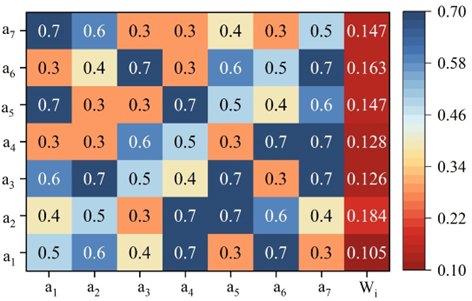
The weight matrix of economic management system is shown in Figure 3. The
weight share of each factor is 22.6%, 11.9%, 30.3%, 18%, and 17.2%,
respectively, and the CR

The weight matrix of the relevant documents of economic management is
shown in Figure 4. The weight share of each factor is 28.6%,
18.8%, 20.6% and 32% respectively, and the CR
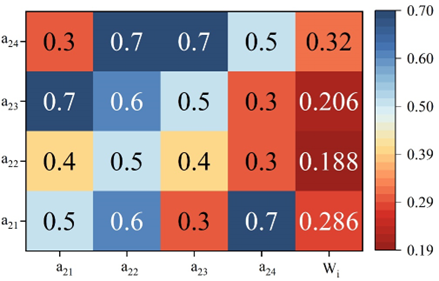
The evaluation weight matrix of the economic management system is
shown in Figure 5. The weight share of each factor is 11.3%,
20.5%, 12.1%, 14.2%, 21%, and 20.9%, respectively, and the CR

The management weight matrix of economic resources is shown in Figure
6. The
weight share of each factor is 32.4%, 30.9%, and 36.7%, respectively,
and the CR
The weight matrix of economic objectives realized by planning is
shown in Figure 7. The weight share of each factor is 23.2%,
25.6%, 28.9%, and 22.3%, respectively, and the CR
The weight matrix of event handling measures is shown in Figure 8. The
weight share of each factor is 43.6% and 56.4% respectively, and CR
The data analysis weight matrix is shown in Figure 9. The weight share of
each factor was 33.8%, 35.2% and 31%, respectively, and the CR
The weights of the factors on the target layer were calculated by combining the data obtained above and combining them with formula (2), and the results of the calculations are shown in Table 3. Among the 7 factors in the guideline layer, the factor of relevant documents for economic management (a2) has the largest weight, accounting for 18.4%. Among the weights of the 27 indicators, the factors of recording and preserving incidents (a62) and preventing the spread of incidents (a61) have the largest weights, accounting for 0.092 and 0.071, respectively.
Combining FAHP-FCE method to conduct a comprehensive evaluation of the level of economic management standardization of enterprise A based on intelligent decision-making system. The weighted value judgment standard of economic management standardization is shown in Table 4, which is divided into 5 levels.
Ten experts are invited to conduct a full research on the management
level of the enterprise’s economic management standardization level,
take various ways such as personnel interviews, reviewing information,
checking records and questionnaires, etc., and in accordance with the
evaluation index system constructed in the previous section,
comprehensively sort out and analyze each evaluation index, and make
evaluations respectively according to the grade division in Table 4. The
statistical matrix of single-factor indicators is normalized, from which
the total evaluation matrix of economic management standardization level
is obtained
The evaluation matrix of the level of standardization of economic
management is obtained using (4):
Calculate the evaluation score for the level of economic management
standardization using formula (3):
According to the classification set in Table 1, the economic
management standardization level of enterprise A is 80.955
| Criterion layer | Factor layer | Sort | |||
|---|---|---|---|---|---|
| a |
0.105 | a |
0.226 | 0.024 | 21 |
| a |
0.119 | 0.012 | 27 | ||
| a |
0.303 | 0.032 | 17 | ||
| a |
0.18 | 0.019 | 22 | ||
| a |
0.172 | 0.018 | 23 | ||
| a |
0.184 | a |
0.286 | 0.053 | 4 |
| a |
0.188 | 0.035 | 14 | ||
| a |
0.206 | 0.038 | 12 | ||
| a |
0.32 | 0.059 | 3 | ||
| a |
0.126 | a |
0.113 | 0.014 | 26 |
| a |
0.205 | 0.026 | 18 | ||
| a |
0.121 | 0.015 | 25 | ||
| a |
0.142 | 0.018 | 24 | ||
| a |
0.21 | 0.026 | 19 | ||
| a |
0.209 | 0.026 | 20 | ||
| a |
0.128 | a |
0.324 | 0.041 | 10 |
| a |
0.309 | 0.04 | 11 | ||
| a |
0.367 | 0.047 | 7 | ||
| a |
0.147 | a |
0.232 | 0.034 | 15 |
| a |
0.256 | 0.038 | 13 | ||
| a |
0.289 | 0.042 | 9 | ||
| a |
0.223 | 0.033 | 16 | ||
| a |
0.163 | a |
0.436 | 0.071 | 2 |
| a |
0.564 | 0.092 | 1 | ||
| a |
0.147 | a |
0.338 | 0.05 | 6 |
| a |
0.352 | 0.052 | 5 | ||
| a |
0.31 | 0.045 | 8 |
| Grade | 95 | 80 | 65 | 45 | 30 |
|---|---|---|---|---|---|
| Score | Good | Better | Medium | Poor | Bad |
| Factor layer | Bad | Poor | Medium | Better | Good |
|---|---|---|---|---|---|
| a |
0 | 0.113 | 0.174 | 0.213 | 0.5 |
| a |
0 | 0.174 | 0.113 | 0.5 | 0.213 |
| a |
0 | 0 | 0 | 0.166 | 0.834 |
| a |
0 | 0 | 0.166 | 0.666 | 0.168 |
| a |
0 | 0 | 0.287 | 0.5 | 0.213 |
| a |
0 | 0.113 | 0.174 | 0.213 | 0.5 |
| a |
0 | 0.174 | 0.113 | 0.5 | 0.213 |
| a |
0 | 0.113 | 0.174 | 0.213 | 0.5 |
| a |
0 | 0.174 | 0.113 | 0.5 | 0.213 |
| a |
0 | 0 | 0.287 | 0.5 | 0.213 |
| a |
0 | 0.113 | 0.174 | 0.213 | 0.5 |
| a |
0 | 0.287 | 0 | 0.5 | 0.213 |
| a |
0 | 0.287 | 0 | 0.213 | 0.5 |
| a |
0 | 0.174 | 0.113 | 0.5 | 0.213 |
| a |
0 | 0.113 | 0.174 | 0.213 | 0.5 |
| a |
0 | 0.174 | 0.113 | 0.5 | 0.213 |
| a |
0 | 0 | 0 | 0.166 | 0.834 |
| a |
0 | 0 | 0 | 0.166 | 0.834 |
| a |
0 | 0.113 | 0.174 | 0.213 | 0.5 |
| a |
0 | 0.174 | 0.113 | 0.5 | 0.213 |
| a |
0 | 0 | 0.166 | 0.666 | 0.168 |
| a |
0 | 0 | 0.287 | 0.5 | 0.213 |
| a |
0 | 0.174 | 0.113 | 0.5 | 0.213 |
| a |
0 | 0.113 | 0.174 | 0.213 | 0.5 |
| a |
0 | 0 | 0.287 | 0.5 | 0.213 |
| a |
0 | 0.113 | 0.174 | 0.213 | 0.5 |
| a |
0 | 0 | 0.213 | 0.287 | 0.5 |
The study applies the constructed decision support system to enterprise A for economic standardization management. According to the fuzzy hierarchical analysis method to calculate the weights of the indicators affecting the enterprise’s economic standardization management, and quantify the level of economic standardization management through the fuzzy comprehensive evaluation method.
1) Among the weights of the 27 indicators, event recording and preservation (0.092) and preventing the spread of events (0.071) account for the largest proportion, indicating that these two factors have a greater degree of influence on the level of economic standardized management of enterprises.
2) The evaluation score of enterprise A’s economic management
standardization level is
1970-2025 CP (Manitoba, Canada) unless otherwise stated.